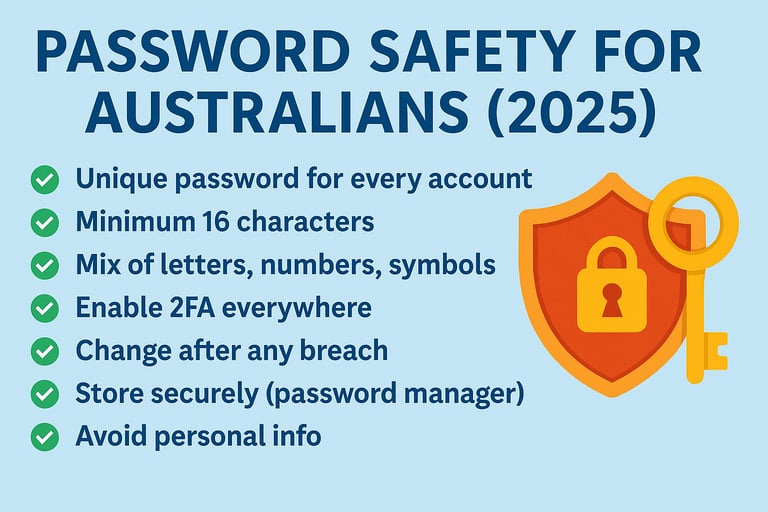Top 7 Password Mistakes Australians Still Make in 2025 (And How to Fix Them)


Top 7 Password Mistakes Australians Still Make in 2025 (And How to Fix Them)
Introduction – A Nation Still at Risk
Despite years of cybersecurity campaigns, Australians are still falling into the same password traps — and cybercriminals are taking full advantage.
According to the National Anti-Scam Centre (which compiles Scamwatch, ACSC, and ASIC reports), Australians lost over $2.03 billion to scams in 2024. Weak and reused passwords remain one of the most common entry points for account takeovers, identity theft, and financial fraud.
Early 2025 trends aren’t encouraging. In just the first four months of the year, Australians reported $119 million in scam losses, with credential theft making up a large proportion of phishing-related incidents (ACCC). Many of these could have been prevented with stronger password habits.
“If you’re still using ‘password123’ or reusing the same password across multiple accounts, you’re essentially leaving the front door unlocked for hackers,” warns Lisa Byrne, a senior analyst at the Australian Cyber Security Centre (ACSC).
This investigative feature breaks down the Top 7 password mistakes Australians continue to make in 2025, backed by real examples, expert advice, and step-by-step fixes.
1. Using Weak, Guessable Passwords
The Problem:
In 2025, “123456”, “password”, and “qwerty” are still among the most used passwords in Australia. Cybercriminals use credential stuffing tools that can crack such weak passwords in under a second.
Case Study:
In March 2025, a Melbourne café owner had their small business Instagram hacked after using “coffeelover2020” as the password. Within hours, scammers posted fake promotions, tricking followers into sharing credit card details.
Fix:
Use a password manager (e.g., Bitwarden, LastPass, or 1Password).
Generate passwords of at least 16 characters with a mix of letters, numbers, and symbols.
Avoid dictionary words, birth years, or anything tied to your personal life.
See our guide on Top 10 Online Scams Targeting Australians in 2025 to learn how stolen credentials are used in fraud.
2. Reusing the Same Password Across Multiple Accounts
The Problem:
One breach can unlock dozens of accounts if you reuse the same password. This “domino effect” is a hacker’s dream.
Case Study:
A Sydney university student used the same password for her email, Netflix, and MyGov account. When her details leaked in a gaming site breach, hackers accessed her tax records within 48 hours.
Fix:
Every account should have a unique password.
A password manager can automatically store and fill in different ones.
Periodically check for breaches using Have I Been Pwned.
Read our How to Report Online Scams in Australia – Step-by-Step Guide (2025) for what to do if your credentials are stolen.
3. Ignoring Two-Factor Authentication (2FA)
The Problem:
Many Australians skip enabling 2FA because it “takes too long” — but it can block 99% of automated hacking attempts.
Case Study:
In early 2025, a Perth retiree had $14,000 stolen after email hackers bypassed a simple password and intercepted a bank transfer. 2FA could have stopped the theft.
Fix:
Enable 2FA on email, banking, and social media accounts.
Use authenticator apps (Google Authenticator, Authy) instead of SMS codes when possible.
Tip: Many banks in Australia now offer biometric authentication as an additional layer.
4. Falling for Phishing Emails
The Problem:
Hackers trick you into entering your password on a fake website. These phishing sites are now almost indistinguishable from the real ones.
Case Study:
A Brisbane couple received an email from “Australia Post” asking them to “reschedule a missed delivery”. The link led to a fake login page that stole their email password.
Fix:
Hover over links before clicking.
Check domain names carefully.
Report phishing to ReportCyber and Scamwatch.
Our blog How to Spot a Phishing Email – Easy Tips for Seniors provides real-world examples.
5. Not Updating Passwords After a Breach
The Problem:
Many Australians don’t change passwords even after receiving a “data breach” email.
Case Study:
After the Optus breach in 2022, tens of thousands of customers never changed their passwords. Some were hacked years later when the stolen data resurfaced on the dark web.
Fix:
Change passwords immediately after any breach.
Use security alerts from password managers to detect compromised accounts.
6. Writing Passwords Down or Storing Them Insecurely
The Problem:
Keeping passwords in notebooks, sticky notes, or unencrypted files is a goldmine for anyone who gains physical access to your space.
Case Study:
A regional NSW teacher kept all her banking passwords in a “private” Excel sheet on her school laptop. A malware infection exposed every account.
Fix:
Store passwords in encrypted password managers.
If you must write them down, store in a locked safe — not your desk drawer.
7. Using Personal Information
The Problem:
Using your pet’s name, birthday, or home address makes guessing your password easier — especially for people who know you or follow you online.
Case Study:
A scammer guessed a Gold Coast man’s superannuation login by combining his dog’s name from Instagram and his year of birth.
Fix:
Avoid anything that can be found on your social media.
Use random word combinations or passphrase.
Password Safety Checklist for Australians (2025)
✅ Unique password for every account
✅ Minimum 16 characters
✅ Mix of letters, numbers, symbols
✅ Enable 2FA everywhere
✅ Change after any breach
✅ Store securely (password manager)
✅ Avoid personal info
Final Word
Passwords remain your first line of defence in 2025. Weak, reused, or stolen passwords are a gift to cybercriminals. But with the right habits, Australians can drastically reduce the risk of identity theft and financial fraud.
Internal Link Recap:


Safety
Empowering families to navigate online risks securely.
Community
“CyberShield Academy © 2025. All rights reserved.”